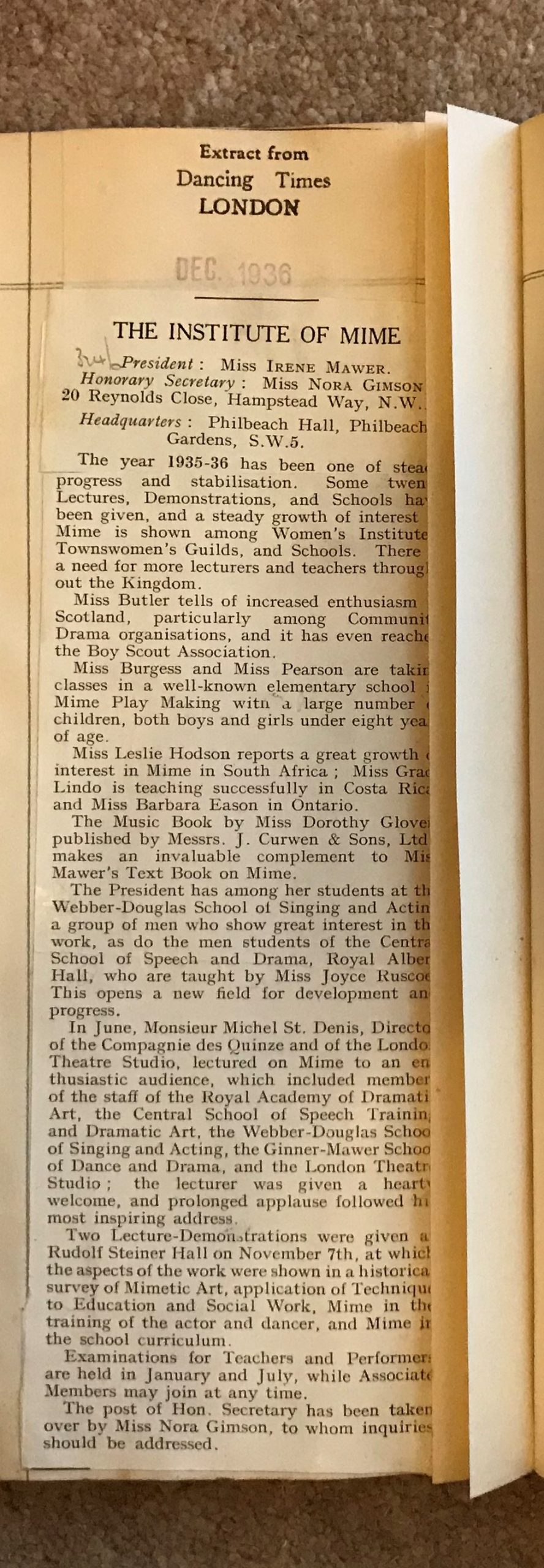Institute of Mime. overview 1936
Dancing Times, December 1936
THE INSTITUTE OF MIME
This newspaper article gives a run-down of what had been happening within the Institute of Mime during the preceding year (1935-36).
Described as making steady progress, the Institute had some twenty lectures/demonstrations/schools and the Women’s Institute had shown a lot of interest in mime, as it also did the Townswomens’s Guilds and some Schools. Although the school isn’t named, Miss Burgess and Miss Pearson had been holding mime classes for both girls and boys under the age of eight in a well-known elementary school. I would imagine that this was a private, fee-paying school.
Indeed, such was the progress in the growth of mime, that there was a shortfall of available teachers in the UK.
In Scotland, the appreciation of mime continue to grow – including an introduction to the Boy Scouts Association.
Moving further afield, teachers were progressing well in South Africa (Miss Leslie Hodson), Costa Rica (Miss Grace Lindo), and Canada (Miss Barbara Eason).
Dorothy Glover’s music book is promoted as being an invaluable complement to Irene Mawer’s text book The Art of Mime.
As well as the boys at the elementary school, there was further interest from the male population among men at the Webber-Douglas School of Singing and Acting, as well as men at the Central School of Speech and Drama.
Central School was still based in rooms at the Royal Albert Hall and this is where Irene Mawer had first met Ruby Ginner. At that time (circa 1912) there hadn’t been any formal mime training, and Irene Mawer was later employed as a teacher there. In this newspaper article, the teacher is Miss Joyce Ruscoe, who I believe was a Ginner-Mawer graduate (though I don’t have precise evidence) and who, therefore, would have been teaching the Irene Mawer Method of Mime and Movement at the Central School, though the method was not called this at the time.
Either way, by 1938 Joyce Ruscoe was the Vice President of the Institute of Mime and would, therefore, presumably be trained in the Irene Mawer Method and have passed the exams at the Institute of Mime.
In June (1935 or 1936) Monsieur Michel St Denis (at that time, Director of the Compagnie des Quinze and the London Theatre Studio) gave a lecture on mime, to members of the Institute of Mime.
I need to find out where Saint-Denis learned his mime. He must have been good at mime and his views must have chimed with those of Irene Mawer, otherwise I can not see that he would have been invited to speak at the Institute of Mime (founded by Irene Mawer to standardise mime across the UK and beyond). Miss Mawer had been astute in engaging his services, as his ideas on actor training have had a profound influence on the development of European theatre from the 1930s onwards.
Included in the audience for Michel Saint-Denis’s lecture on mime were members of staff from the Royal Academy of Dramatic Art (RADA); the Central School of Speech Training and Dramatic Art; the Webber-Douglas School of Singing and Acting; the Ginner-Mawer School of Dance and Drama; and the London Theatre Studio.
The Rudolf Steiner Hall in London was the venue in November 1936 for two lecture-demonstrations. As well as covering the history of mime; and showing how mime could be used in the training of the actor and dancer; and mime in the school curriculum; there was also a focus on how Irene Mawer’s technique could be used in an educational and socially useful way.
The role of Honorable Secretary changed from Miss Joyce Ruscoe to Miss Nora Gimson.
It would seem that Irene Mawer played an important part in the creation of a mime technique which was found to be useful in the training of actors. However, the history books do not reflect her work, so please like/share/comment, etc, so that the internet search engines will more easily find information about Irene Mawer. Thank you.

